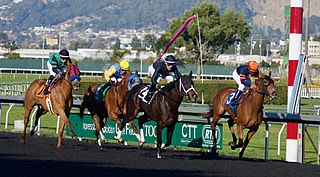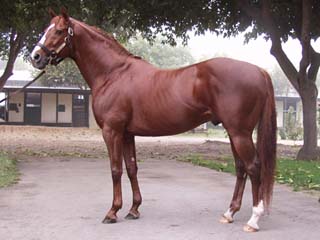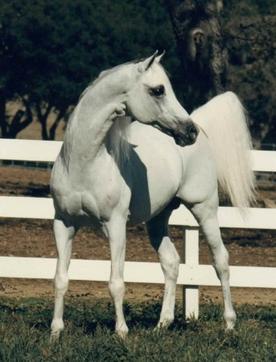
Northern Dancer was a Thoroughbred that, in 1964, became the first Canadian-bred horse to win the Kentucky Derby. After being retired from racing, he became one of the most successful sires of the 20th century. He is considered a Canadian icon and was inducted into the Canadian Sports Hall of Fame in 1965. Induction into the Racing Hall of Fame in both Canada and the United States followed in 1976. As a competitor, The Blood-Horse ranked him as one of the top 100 U.S. Thoroughbred racehorses of the 20th century. As a sire of sires, his influence on the breed is still felt worldwide.

Horse racing is an equestrian performance sport, typically involving two or more horses ridden by jockeys over a set distance for competition. It is one of the most ancient of all sports, as its basic premise – to identify which of two or more horses is the fastest over a set course or distance – has been mostly unchanged since at least classical antiquity.

Eclipse was an undefeated 18th-century British Thoroughbred racehorse who won 18 races, including 11 King's Plates. He raced before the introduction of the British Classic Races, at a time when four-mile heat racing was the norm. He was considered the greatest racehorse of his time and the expression, "Eclipse first, the rest nowhere" entered the English vernacular as an expression of dominance.

Gunrock is the official mascot of the UC Davis Aggies, the athletic teams that represent the University of California, Davis, and was based on Gunrock (1914–1932), an American Thoroughbred stallion, and the son of English Triple Crown winner Rock Sand. He was related to the American Thoroughbred racehorse Man O' War (1917–1947), who was out of Mahubah (1910–1931), bay Thoroughbred mare by Rock Sand out of Merry Token. Gunrock was bred by Clarence Mackay, and likely born in Kentucky in 1914. He had an unsuccessful racing career as a 2-year-old, and was retired to stud by age 6 in 1920.
Sadler's Wells was an American-bred, Irish-trained champion Thoroughbred racehorse and outstanding sire. He was the 1984 European Champion miler after winning the Irish 2,000 Guineas, Eclipse Stakes and Phoenix Champion Stakes in that year. He also finished second in the French Derby and the King George VI and Queen Elizabeth Stakes.
Deputy Minister was a Canadian-bred Thoroughbred horse racing Champion. At age two, he won eight out of his nine starts and was voted both the Sovereign and Eclipse Awards for Champion 2-Year-Old in Canada and the United States respectively. He also received Canada's Sovereign Award for Horse of the Year. Although his three-year-old campaign was restricted by injury, Deputy Minister rebounded at age four with several major wins.

Fair Play was an American-bred Thoroughbred racehorse who was successful on the track, but even more so when retired to stud. He is best known as the sire of Man o' War, widely considered one of the greatest American racehorses of all time. On the racetrack, Fair Play was known for his rivalry with the undefeated Colin, to whom he finished second in the Belmont Stakes. Later, Fair Play was the leading sire in North America of 1920, 1924 and 1927, and the leading broodmare sire of 1931, 1934 and 1938. He was inducted into the National Museum of Racing and Hall of Fame in 1956.
Ballymoss (1954–1979) was an Irish Thoroughbred racehorse. In a racing career that lasted from 1956 until November 1958, he ran seventeen times and won eight races. In 1957, he became the first horse trained in Ireland to win the St Leger Stakes. The following season, he was Europe's leading middle-distance horse, winning the King George VI & Queen Elizabeth Stakes and the Prix de l'Arc de Triomphe.

Bull Lea was an American Thoroughbred racehorse who is best known as the foundation sire responsible for making Calumet Farm one of the most successful racing stables in American history. In their article on Calumet Farm, the International Museum of the Horse in Lexington, Kentucky wrote that Bull Lea was "one of the greatest sires in Thoroughbred breeding history."

Bask, bred at the Albigowa State Stud in Poland, was a bay Arabian stallion who was imported into the United States in 1963 by Dr. Eugene LaCroix of Lasma Arabians and became a major sire of significance in the Arabian breed.
The Tersk Stud is a horse breeding farm, and it was used to restore the Russian horse population, which suffered heavy losses during the 1917-1923 Revolution. It was officially established on 11 February 1921, on the orders of Marshal Semyon Budyonny.

The Thoroughbred is a horse breed developed for horse racing. Although the word thoroughbred is sometimes used to refer to any breed of purebred horse, it technically refers only to the Thoroughbred breed. Thoroughbreds are considered "hot-blooded" horses that are known for their agility, speed, and spirit.
Almutawakel was a British thoroughbred racehorse sired by Machiavellian and the Irish stakes-winning Green Desert mare, Elfaslah.

Sheila Varian was an American breeder of Arabian horses who lived and worked at the Varian Arabians Ranch near Arroyo Grande, California. She grew up with a strong interest in horses, and was mentored in horsemanship by Mary "Sid" Spencer, a local rancher and Morgan horse breeder who also introduced Varian to the vaquero or "Californio" tradition of western riding. She started her horse ranch, Varian Arabians, in 1954 with the assistance of her parents. Raising and training horses was her full-time occupation beginning in 1963. She used vaquero-influenced methods of training horses, although she adapted her technique over the years to fit the character of the Arabian horse, which she viewed as a horse breed requiring a smart yet gentle approach.

Airborne was an Irish-bred British-trained Thoroughbred racehorse and sire. After showing little worthwhile form as a two-year-old, Airborne improved to become one of the leading three-year-olds in Britain in 1946. He won five successive races including two Classics: the Derby at Epsom and the St Leger at Doncaster. He was the most recent of four greys to have won the Epsom Classic. Airborne went on to have a stud career of limited success.

Naborr, originally named Nabor, was a gray Arabian stallion foaled in Russia at the Tersk Stud. He was sired by Negatiw, a Russian-bred stallion with Crabbet ancestry, out of the Polish-bred mare Lagodna. After establishing himself on the race track and show ring in the former USSR, Naborr was exported to Poland, where he lived for seven years, and from there was purchased for import to the United States by a wealthy Arabian horse breeder from Arizona, Anne McCormick. Upon her death, Naborr was sold in 1969 to Tom Chauncey and Wayne Newton for $150,000, which was at the time the highest price ever paid for an Arabian horse at auction. He went on to become a leading sire of champion Arabian horses in the United States and Canada.

Bandos was a gray Arabian stallion with Crabbet ancestry. He was sired by Negatiw, a Tersk bred stud, out of Bandola, who was known by the title of "Queen of Poland". Bandos was a sire in Poland for 11 years, and in 1982, he was imported to the United States.
Ronteza (1954–1982) was a bay Arabian mare who was the first of her breed to win the Grand Champion Reined Cow Horse class. She was sired by Witez II, out of Ronna.
Australian was a British-bred Thoroughbred racehorse and sire. He was exported to the United States where he had modest success as a racehorse but became a very successful and influential breeding stallion.